
- Around Lake Atitlan

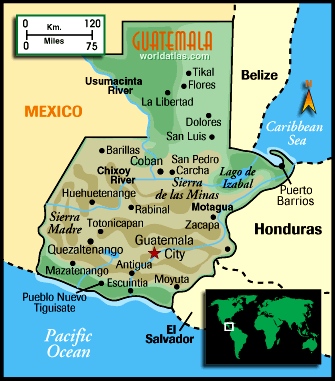
Lake Atitlan (Lago de Atitlan) is a large lake 50 miles west of Guatemala City. It is surrounded by hills made from ancient volcanos, with twelve small indigenous villages which line its shores. The most popular village is Panajachel (pronounce 'j' as 'h'). It is casually referred to as simply 'Pana', but as there are a very large number of tourists, some call it 'gringo-tenango'.
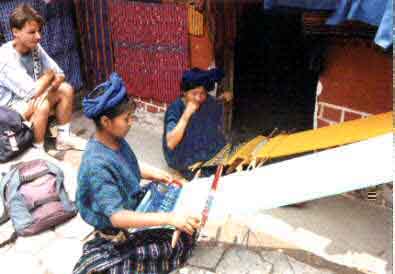
I met a friend in Pana and we decided to take a walk to a couple of nearby towns. This was the first town. We met this lady and her daughter who were weaving and selling their cloth. The daughter is 13 years old, and has worked with her mother for the last 5 years. I thought it amazing, when children of that age would normally be running around in the street playing with their friends, and if told to work, would complain all day. In fact, it would be illegal. But for this girl it is just the way of life. As you can see, the typical colours of this village are shades of blue. When I asked the mother why she was weaving with yellow, she told me it was for the tourists - I laughed.

Here's a nice one of the girl.

This is at San Pedro on the far side of lake Atitlan. It is far less touristed than Pana. There's not much there, but it's nice and relaxing.
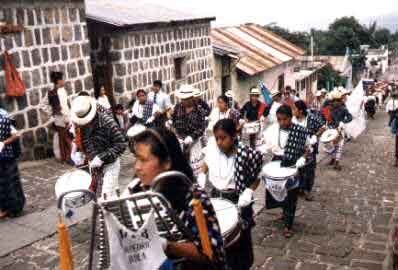
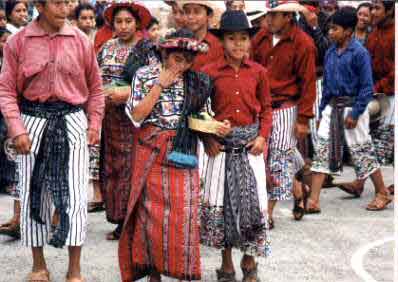
Chichicastenango
I went out for a day trip to Chichicastenango (try saying that with a few tequilas under your belt). On the weekend this is the hottest market around. Evidently on the off days there's hardly anything there at all.
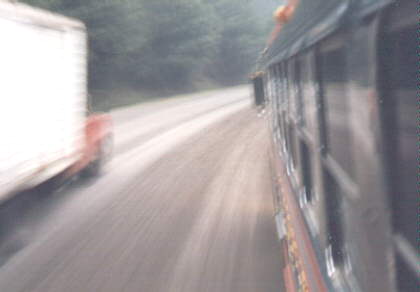
Yet another hair-raising bus ride. I think the Guatemalans are even more rampant than the Mexicans. The public transport here is the disused old yellow school busses from USA. Now and then you get to see a 'bus graveyard' in a paddock on the side of the road. And with the way these guys gun them, and the condition of the roads, there's no wonder.
I was in this bus with a bunch of other men. We were all holding onto the bars of the seat in front of us to keep from falling out. At one stage I got launched out, and in the process let out a 'woohoo!', which made the other guys turn and chuckle. By this stage I thought "well, if you can't beat 'em, bloody well join 'em". So I got up out of my seat, hung my head out of the window and started beckoning to the bus behind us in a 'come on, dare ya to catch us' manner... so they tried. Seeing what was going on, this brought a smile to our driver's face. And before we knew it the chase was on. At one stage, I looked up the centre of the bus to see the driver leaning into a right hand bend, with one hand on the gearstick and the other trying to keep the corner of the dirt road.
Bear in mind here that Chichi is in the hills, so we often had steep drop-offs on the side of the road. What a start to the day.

While wondering around the market area I stumbled across this huge area where there were lots and lots of little... eateries. That's the only way I can explain it. All they consisted of was a burner with some pots and a hot plate. They offered soup, meat and rice. There didn't seem to be any difference in food, cost or cleanliness, so I just sat down at the nearest one and had lunch.

This photo was taken from the steps outside one of the two main churches. Incense is burned on these steps all day. Starting at the bottom of the steps, the market stretches all the way to the steps of the other church at the opposite end of the street. The first stall on the right there is selling painted face masks for celebrations etc.
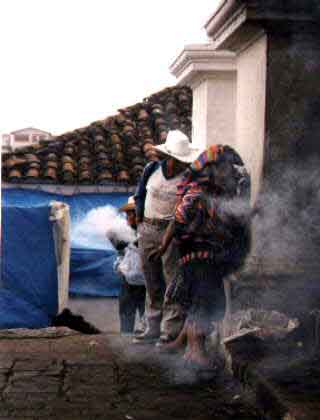
This is at the top of the steps. To the right is the door to the church. The ladies here stand just outside the door, swinging tins of burning insense back and forth as they prey (you can see the tin in her right hand). Once finished, they enter the church, where I guess they do some more preying.
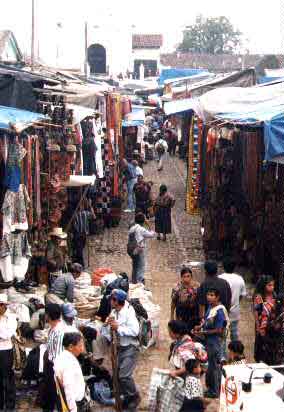
This also is from the top of the steps. You can see the large door of the other church at the end of the street, just off to the left. There are many other streets off to the sides. It looks like this one is primarily selling cloth (tela). At the bottom left are a number of baskets of cloth and clothes. At the bottom right is a white cart which a guy pushes around selling lots of home-made icecreams. Sounds good, but if they don't have a commercial wrapper around, make sure you have adapted to the food here. And even then go easy. I quite like these, but learned my lesson when one time (at Agua Azul, Mexico) I ate four of these home made ice-creams over two days, and had a sore stomach for the following two days.

As I was standing at the top of the steps, a band emerged from the hall, playing slow, solemn music, which made everybody stop what they were doing, gather around and watch. Then came a number of sad faced, weeping people, followed by a coffin. The funeral procession very slowly wound its way through the streets, heading for the local cemetery.
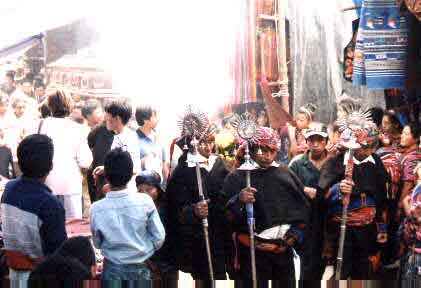
These guys, I guess, were some sort of priests, leading the procession. Note the cask to the upper left.